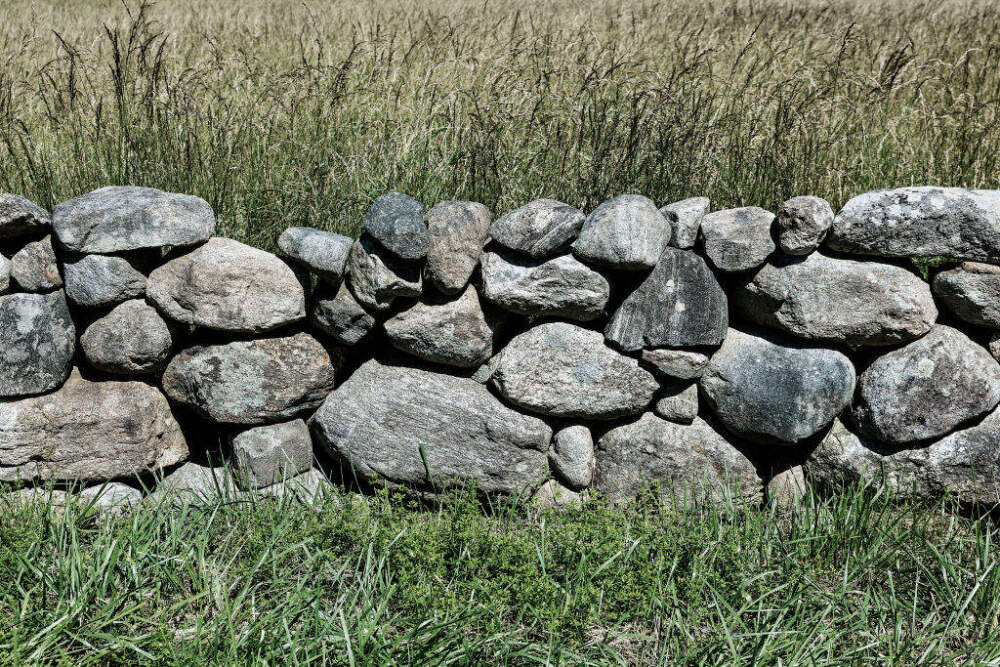Advertisement
The Weekender: Boston's Saturday Morning Newsletter
Uncovering the hidden history of New England’s many stone walls

Editor's Note: This is an excerpt from WBUR's Saturday morning newsletter, The Weekender. If you like what you read and want it in your inbox, sign up here.
Picture the Great Wall of China. Now, picture about 18 Great Walls of China, lined up next to each other.
Only then do you get close to the length of all the stone walls that used to divvy up New England back in the 1800s, when agriculture dominated the region’s landscape.
At its peak, the region had an estimated 240,000 miles of these field- or quarry-stone walls. That’s enough to circle the Earth around the equator nine — almost 10 — times. And around 100,000 miles of them still exist today, snaking through forests that were once farmland.
These unassuming-but-sturdy walls have become so iconic to the New England aesthetic that many city folk who bought country homes or farmland after the Civil War made it a point to preserve or reconstruct them, according to Dr. Robert Thorson, a geologist and professor of earth sciences at the University of Connecticut (and perhaps the region’s foremost stone wall expert).
“The walls that were originally barriers between our fields have become something that binds our region together,” Thorson recently told me. “People in [New England] are all nuts about their stone walls.”
I spoke with Thorson to learn more about these curious, mossy structures, our region’s dedication to them and how citizen scientists are using new technology to better understand them.
Rocky soil leads to rocky walls
Many of New England’s stone walls were initially constructed to deal with a problem: An excess of pesky stones in the soil.
Topographically, things have always been rocky around here, thanks to all the piecemeal stones that broke off mountains thanks to receding glaciers. While some walls were built intentionally to section off farmland, some simply served as a quick solution to all the stone farmers encountered while tilling the fields.
“The best place to dump a stone is along a fence line,” Thorson said. “So really, most of the walls in New England started as linear landfills. If you go to a library, the books aren’t all over the floor. You’d do the same with sprawling stone heaps. You wouldn’t leave them on the ground. You pile them up.”
Eventually, industrialization, the Civil War (during which farmers were paid to give up their stone to quarries) and reforestation led to a decline in the region’s stone walls. Still, city-dwellers who moved to the countryside after the war constructed walls of their own.
“Many folks who lived in the city wanted a ‘country place,' ” said Thorson. “These folks would build [stone] walls to their specification. They would use the old farmers' walls and build nicer-looking walls out of them, [or] use rock that came from a quarry, too, if they wanted nicer stones.”
These aren’t the same walls a farmer may have built, Thorson added. “But it’s a wall just the same,” he said, and it now contributes greatly to the aesthetics of and cultural associations with our landscape.
Demystifying the hidden stories in our walls
Regional love for stone walls has inspired decades of wall mapping projects. For years, researchers working for the Harvard Forest in Petersham have used maps and Geographic Information Systems (GIS) to gain data on stone walls. But over in the Granite State, citizen scientists are taking stone wall research a step further. The “NH Stone Wall Mapper” project is employing LiDAR technology to find walls nestled deep in the forest, far out of sight.
LiDAR (which stands for Light Detection And Ranging) isn’t particularly new, but it is providing an innovative way to look at stone walls. The tech uses lasers to survey environments, detecting formations hidden beneath the cover of the trees, likeMayan ruins. One of the few things LiDAR can’t fully determine is age, Thorson says. Still, the technology is making it a lot easier to figure out just how many stone walls still exist in the forest-dense state. You can even see for yourself using the project’s easy-to-use interactive map.
See our stony history IRL
If you want to check out some interesting or picturesque stone walls in Massachusetts, Thorson has a few hikes to recommend:
- Minuteman National Historical Park in Concord and Lexington: “It’s a fun thing to go look at the walls when you’re there for other reasons.”
- The Cape and Islands: “Cape Cod has stone walls. Block Island and Martha’s Vineyard have them, too,” says Thorson.
- The Appalachian Trail: “You’re going to see stone walls all of the way, especially as you get lower elevation.”
